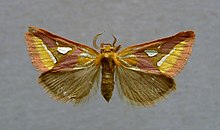| Axia | |
|---|---|
 | |
| Axia margarita | |
| Scientific classification | |
| Domain: | Eukaryota |
| Kingdom: | Animalia |
| Phylum: | Arthropoda |
| Class: | Insecta |
| Order: | Lepidoptera |
| Family: | Cimeliidae |
| Genus: | Axia Hübner, 1821 |
| Synonyms | |
| |
Axia, the gold moths, is a genus of moths whose precise relationships within the macrolepidoptera are currently uncertain, but they currently are placed within the superfamily Drepanoidea. Uniquely, they have a pair of pocket-like organs on the seventh abdominal spiracle of the adult moth [1] which are possibly sound receptive organs. [2] They are quite large and brightly coloured moths that occur only in southern Europe and feed on species of Euphorbia . Sometimes they are attracted to light. [1] The genus was first described by Jacob Hübner in 1821.
Contents
One species, Epicimelia theresiae , was formerly included in this genus, but has since been recognized as distinct; it represents the only other described genus in the family. [3]